by Larry Williams | Jan 27, 2014
This week, Northwest Florida is once again receiving some bitter cold temperatures. The freezing weather two weeks ago resulted in some cold damage to some local citrus trees. Cold injured citrus trees can take a while to become evident.
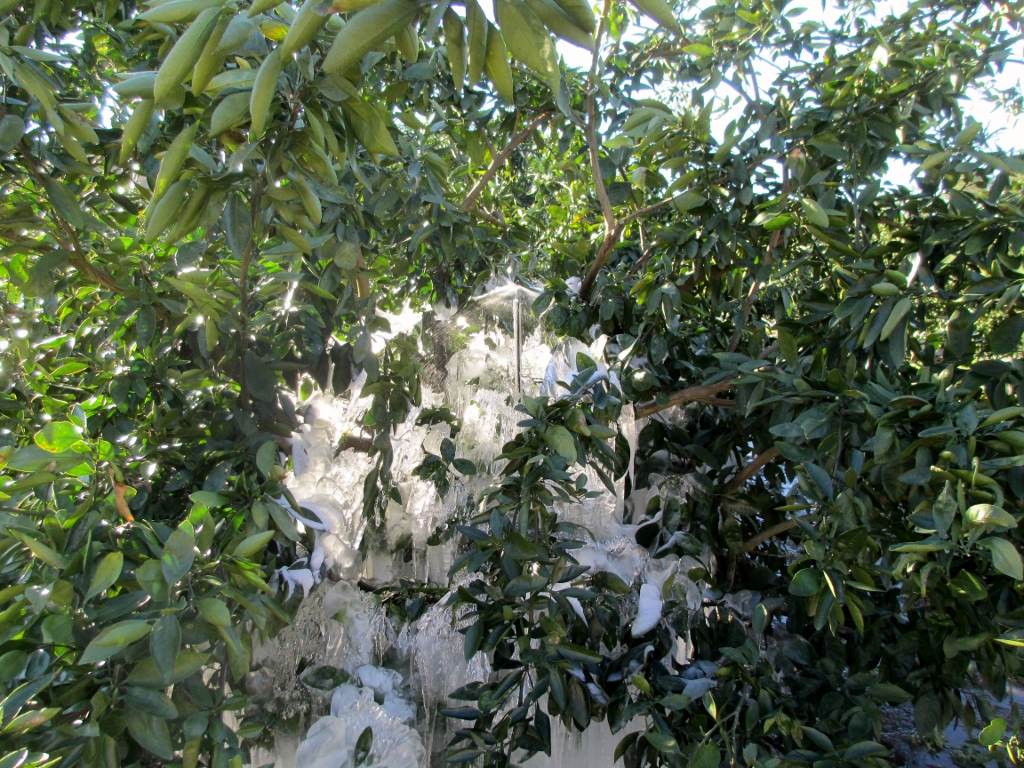
Citrus in freezing weather, under protective microsprinkler irrigation. Image Credit Doug Mayo UF IFAS
What appears to be damage will not always be permanent. Never be in a hurry to remove cold injured tissue from a citrus tree. Citrus, especially Satsuma, can be very resilient and will often re-sprout on injured tissue. Pruning before this can happen can remove fruit producing branches. Leaves on a freeze-damaged citrus tree will be hard and brittle.
If freeze damage is severe, the leaves will collapse, dry out and fall from the tree. It’s normal for leaves to take on a wilted or drooping appearance during periods of low temperatures. Don’t confuse this with freeze damage. Frozen leaves will not be wilted – they will be hard and brittle. Freeze damage can also cause the trunk and larger branches to split and the bark to become loose. Twigs and branches may continue to die for up to two years following a severe freeze.
Unless the soil becomes dry, be careful to not water cold injured citrus trees during warm periods that often follow freezes. This will delay the tree’s growth and keep the tree in a more dormant state. However, it is important to not let citrus trees go totally dry, because this will increase freeze damage. Later on, if you see that the damaged tree is putting on new growth, it’s okay to give it a little water.
It is best to not prune or fertilize citrus trees during fall and winter.Delay pruning of damaged limbs until late spring or summer because it’s difficult to determine the extent of damage until spring growth takes place. Pruning also may encourage new tender growth during the cold season.
If it appears that you’ve lost half the tree in a freeze, you’ll only need to apply about half as much fertilizer. If you have the situation where many leaves were lost but twigs and branches were not injured, you’ll need to slightly increase the amount of fertilizer. Fertilization should begin after new growth has occurred come spring. It’s a good idea to make frequent light applications rather than one heavy application.
Fertilizing your lawn during fall and winter may not only be damaging to your lawn but it can potentially cause cold injury to your citrus trees, as well. The roots on trees (including citrus) extend two to three times beyond the tree’s branches. As a result, citrus tree roots grow out into the lawn. Tree roots in the lawn are shallow. So, late applications of lawn fertilizer will impact your citrus trees as well. Your lawn and citrus needs ample time to use the fertilizer but yet still have time to go dormant before cold weather arrives.
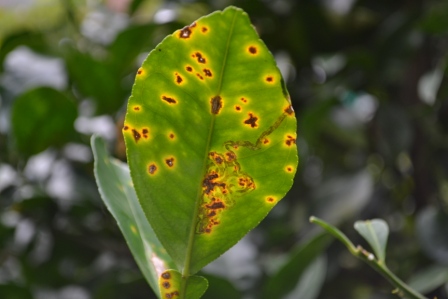
by Blake Thaxton | Nov 25, 2013
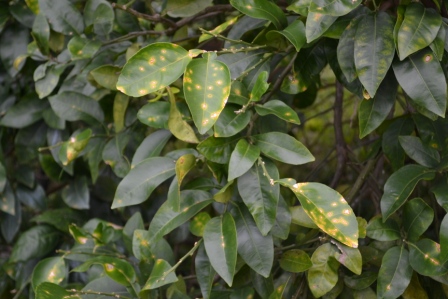
Citrus Canker lesions on leaves. Photo Credit: Beth Bolles, UF IFAS Extension – Escambia County
Authors: Blake Thaxton & Mary Derrick, UF/IFAS Extension – Santa Rosa Co. Mikaela Anderson, FDACS Division of Plant Inspection
Citrus canker is a serious disease of citrus trees that was recently confirmed for the first time in southern Santa Rosa County. Canker is caused by the bacterial pathogen Xanthomonas citri subsp. citri. Citrus canker has been a major pest of citrus in south and central Florida. It is economically damaging to the commercial industry and is also problematic to homeowners because it causes premature fruit drop, discolored fruit, and eventually causes the tree to become unproductive.
Canker was first introduced in 1912 into Florida and was declared eradicated in 1933. The disease was found again in the Tampa area on citrus in 1986. It was declared eradicated in 1994, but once again was found in 1995 in Miami. This time, the disease was not successfully eradicated in part because hurricanes made the disease too widespread to control. Despite its prevalence in south and central Florida, this disease has not been known in the Panhandle. The University of Florida and the Florida Department of Agriculture and Consumer Services’ Division of Plant Industry will be assessing the extent of the disease in Santa Rosa County in the coming months.

Lesions growing through the channels formed by the Citrus Leafminer insect. Photo Credit: Beth Bolles, UF IFAS Extension – Escambia County
How might you know if your citrus is infected by canker? One of the best indicators of canker is the presence of lesions, diseased spots, on the upper and lower surfaces of the leaves. The lesions will be raised and have a rough surface and will be surrounded by yellow halos. Similar lesions may be present on the fruit and stems as well.
[important]If you suspect that your citrus trees may have citrus canker please contact the Division of Plant Industry’s Helpline Center at 1-888-397-1517 before taking any action to reduce accidental spread of this disease. [/important]
before taking any action to reduce accidental spread of this disease. [/important]
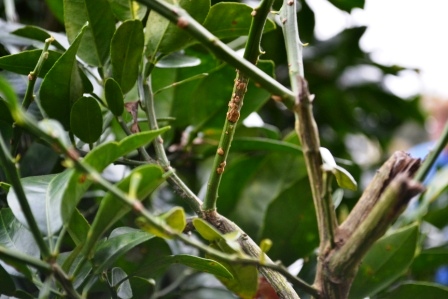
Lesions formed on the stems. Photo Credit: Beth Bolles, UF IFAS Escambia County Extension
The disease is highly contagious to citrus only and spreads rapidly through wind, rain and via people on their hands, clothes, and tools. Do not transport any plant material that shows symptoms of canker. Decontamination practices should be used when going from one citrus tree to the next. Hand washing with soap and water for 20 seconds or more to eliminate bacterium on the skin should be practiced as well as using alcohol-based hand sanitizer. Pruning tools or other tools that come into contact with citrus should be disinfected by a fresh solution of 1 ounce of household bleach to 1 gallon of water. An old or dirty bleach solution is not able to disinfect because the chemical is no longer active.
[warning]Do Not Move a Plant Infected with Citrus Canker. Please Call your local Extension Office for further instructions[/warning]
For more information on citrus canker:
(The University of Florida IFAS Citrus Canker website provides a photo gallery of disease symptoms & information about the disease)
by Matthew Orwat | Nov 18, 2013
On the night of November 13th, a mild freeze of 30°F occured in parts of Northwest Florida. Don’t be caught without a citrus protection plan !
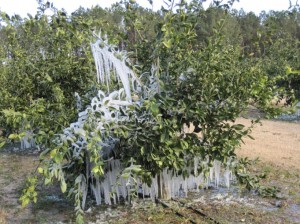
Satsuma Tree protected with micro-irrigation. Image Credit: UF IFAS Jackson County Extension
How cold does it have to get before citrus in Northwest Florida needs to be protected? A concrete answer to this question does not exist. Growers and home gardeners alike must consider several factors including type of citrus grown and the location of the citrus.
Below are a few quick facts to assist growers and home gardeners in determining whether to protect or not to protect their citrus:
- Certain citrus trees such as lime, pomelo, grapefruit, sweet orange, lemon and citron will definitely need protection or need to be moved into a sheltered area. Individuals that grow these types on a consistent basis either wrap their trees with protective covers each season or grow them in containers and move them into greenhouses.
- The meyer lemon, which is in reality a lemon-sweet orange hybrid, is a tree that was introduced to the united states in 1908. Mature dormant meyer lemons can be hardy down to 20°F, with fruit hardy to 26°F. Immature trees, or those that have not reached dormancy, should be protected. Covers made of cloth should be large enough to touch the ground so that heat from the soil can help keep the tree warm.
- Generally, satsuma are cold tolerant down to 15° F, but young trees or trees yet to achieve dormancy are usually only tolerant to 26°F. Fruit should not sustain damage from freezing temperatures above 25°F. Extreme winds sometimes make the effects of freeze events worse, so it is always better to err on the side of protection if the trees are planted in an exposed site.
- Kumquats are the most cold tolerant citrus type grown in Northwest Florida, so protection is not required unless freeze events reach 20°F.
Additional facts to assist the grower or home gardener with citrus protection:
- Plant trees on a south-facing slope, south of windbreaks, on the south side of a structure or under a light canopy if possible. South facing slopes block harmful cold winds. Structures offer radiant heat which aids in the protection of citrus trees. Additionally, light over-story pine canopies allow sufficient sunlight through while reducing frost damage.
- Wrap the trunk with commercial tree wrap or mound soil around the base of the tree up to 2 feet. This will protect the graft of the young tree. Thus, if the branches freeze the graft union will be protected.
- Cover the tree with a cloth sheet or blanket. For additional protection, large bulb Christmas lights can be placed around the branches of the tree. This will increase the temperature under the cover by several degrees. Be sure to use outdoor lights and outdoor extension cords to avoid the potential of fire.
- Water citrus trees. Well watered trees have increased cold hardiness. Do not over-water. If the ground is moist, it is not necessary to water.
- Frames may be installed around young trees to hold the cover. This option keeps the blanket or sheet from weighing down the branches.
- For large production areas, micro-irrigation is an option. This practice will protect citrus trees up to 5 feet, but must be running throughout the entire freeze event. For additional information read this publication on micro-sprinkler irrigation.
- Always remember to remove cold protection once the temperature rises so that the trees do not overheat.
- Do not cover trees with plastic tarp, these will not protect the tree and can “cook” the tree once the sun comes out.
For additional information, contact your local extension office.
by Mary Salinas | Nov 4, 2013
For centuries, people annoyed with plant pests have used oils to control insects, mites, and even some fungal diseases. Current oil products are better than ever!

Sample oil products for pest control. Photo by Mary Derrick.
Commercially available horticultural oils are mineral oils from refined petroleum products. Impurities are removed and then an emulsifying agent is added that allows the oil to mix with water for application. Neem oil is a newer product that has become increasingly popular; the oil is an extract of the seeds of the neem tree.
What are some of the advantages of using an oil for pest control?
- Oils are inexpensive and easy to apply
- Oils can be used on most plants (check the label for a list!)
- Oils control a wide range of pests that feed on plants (again, check the label for a list of pests the product will control!)
- Oils pose a low risk to people, pets, and desirable beneficial predators
- Since oils kill pests by blocking their breathing holes (spiracles) and/or gumming up their mouthparts, there is no chance for resistance to develop
- One product can control both insects and some diseases like powdery mildew at once
- Oils can be combined with some other pesticides to provide greater control
[warning] Don’t combine with, or use within 30 days of, any sulfur based pesticide. The combination can harm your plants![/warning]
There are always drawbacks to a product. What are the drawbacks?
- Some plants (including cryptomeria, junipers, cedars, maples, and redbud) are damaged by oils – check the label!
- Ensure good coverage during spraying as pests must be contacted with the oil in order for the control to work
- Oils break down quickly and reapplication may be necessary
- Check the label for instructions on the temperature range when it can be used. Older formulations generally are safe when temperatures are in the 40 to 80°F range but ultra-fine oils can generally be safely applied during hotter weather.
For further information:
Natural Products for Insect Pest Management from UF IFAS Extension
Insect Control: Horticultural Oils from Colorado State University Extension
Less Toxic Pesticides from Clemson University Cooperative Extension
by Matthew Orwat | Feb 15, 2013
According to the National Weather Service a mild freeze is predicted for Northwest Florida this weekend, specifically Saturday night to Sunday morning. Washington County Horticulture extension agent Matthew Orwat says,” While mature, dormant Satsuma trees are cold hardy down to 14° – 18 °F, young trees need protection if temperatures dip into the upper 20s.”
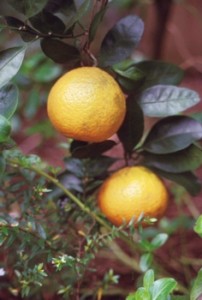
Photo Credits David Marshall
Here are a few techniques to protect young citrus trees from late-season freezes:
- Wrap the trunk with commercial tree wrap or mound soil around the base of the tree up to 2 feet. This will protect the graft of the young tree. Thus, if the branches freeze the graft union will be protected.
- Cover the tree with a cloth sheet or blanket. For additional protection, large bulb Christmas lights may be placed around the branches of the tree. This will increase the temperature under the cover by several degrees. Be sure to use outdoor lights and outdoor extension cords to avoid the potential of fire.
- Water your Satsuma trees. Well watered trees have increased cold hardiness.
- Frames may be installed around young trees to hold the cover. This option keeps the blanket or sheet from weighing down the branches.
- For homeowners with lemon, lime or other less cold hardy citrus, micro-irrigation is an option. This practice will protect citrus trees up to 5 feet, but must be running throughout the entire freeze event. For additional information click here.
- Always remember to remove cold protection once the temperature rises so that the trees do not overheat
- Do not cover trees with plastic tarps, these will not protect the tree and can “cook” the tree once temperatures rise.
Please see the following publications by retired UF / IFAS Extension agents Theresa Friday and David Marshall for additional information regarding freeze protection of citrus.








